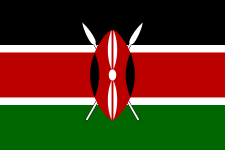The Kenyan flag is a symbol of nationhood that carries a number of meanings associated with the county’s people, history, culture and aspects of sovereignty. The flag is based on a number of other symbols, including the Pan-African flag of the Universal Negro Improvement Association, the flag of the Organization of African Union and that of the country’s first political party ‘The Kenyan African National Union’ (Gatheru 39). The purpose of this paper is to develop a comprehensive analysis of the flag of the Republic of Kenya as a symbol of nationhood.
Design
Within the national flag of the Republic of Kenya, the aspects of color, shield, spears, and fimbriation are important objects that signify different aspects of the state’s nationhood (Ratcliffe 42). First, like other Heraldic and Ancient traditions, much symbolism in the Kenyan flag is associated with colors (Gatheru 54). The flag is a tricolor comprised of Black, Green, and Red with white fimbriations, all of which have significant meanings.

Colors
The three colors are arranged in horizontal bands separated by white fimbriations. The uppermost band is black, which symbolizes the color of the majority of citizens. Like most other sub-Saharan nations, Kenya has more than 90% of its population comprised of black people. In addition, the black color band is a symbol of the determination of the Kenyan people, a symbol that is most likely borrowed from the 19th and 20th-century pan African movements mostly in the US, Europe and the Caribbean (Ratcliffe 42).
Below the black band is a red band running horizontally on the central part of the flag. To the Kenyan people, red color has a historical meaning because it represents ‘blood.’ It is a representation of the blood that was shed when the country was fighting for independence. In fact, Kenya is one of the few nations in the world that used massive bloodshed to force for negotiations for independence and self-government. In the early 1950s, the country, then a colony of Britain, experienced violence perpetrated by the Mau Mau movement. The movement, led by Field Marshall Dedan Kimathi and mostly comprised of the Kikuyu community, was advocating immediate exit of the colonial government and colonial settlers (Ratcliffe 42).
Land problem was the main motive for the movement, considering that the Kikuyu and other communities in the former white highlands of central Kenya were occupied by white farmers (Ehret 179). Although the Mau Mau rebels were finally defeated by British troops, it left thousands of Africans and several white colonialists dead. Its significance is that it is forced the British government in Kenya to reconsider its position and allow negotiations for independence (Ratcliffe 43). Thus, the red band on the Kenyan flag represents the bloodshed, a symbol of the country’s history.
The Green band, which is the bottom-most band on the flag, is a symbol of the country’s nature, the rich agricultural and natural resources, most of which were formerly under the British control. In particular, the country’s central, rift valley, western, and coastal regions have extensive land rich for agriculture (Foottit 77). In addition, extensive national parks, national reserves, and other open areas are important for wildlife conservation and tourism. In fact, for more than four decades, the country relied heavily on agriculture and tourism, which made it possible for significant economic and social developments that are rare in most African nations. Thus, the green color is a symbol of the country’s rich nature.
White color is present in the Kenyan flag in the form of fimbriations separating the other three bands. It is a symbol of peace and harmony. Despite the Mau Mau uprising in the 1950s, the nation has remained relatively peaceful, with a few cases of violence perpetrated by political and economic factors and mostly between different tribes. In general, Kenya has a tradition of peace and harmony and culture that allows the influx of foreigners, especially refugees and foreign investors. After independence, the country adopted a policy of allowing free ownership of property, regardless of an individual’s background, ethnicity, race, and origin (Ratcliffe 42).
The Masai shield and Spears
An important aspect of the flag of the Republic of Kenya is the Masai shield, and two crossed spears that are placed at the central section of the flag. The white color of the shield represents peace, but both the shield and the spear are objects of war in traditional African societies. Therefore, they show that the country’s people are ready to defend the nation and its sovereignty, which was achieved through armed struggle. The Masai shield and the two spears were chosen for their significance among the Masai people (Foottit 86). One of the communities that have retained most of their traditions in the world, the Masai have always used shields and spears to defend their land and attack other communities. History implies that the Masai warriors were one of the forces that barred the Arab and European slave traders from penetrating East Africa (Foottit 86).
Conclusion
After Independence, the Republic of Malawi adopted a flag with similar colors and meanings. Similarly, the republic of southern Sudan, which declared independence in 2011 after succeeding from Sudan, adopted similar colors and meanings. Thus, the Kenyan flag has several objects that symbolize the country’s nationhood.
Works Cited
Ehret, Charles. An African Classical Age: Eastern and Southern Africa in World History. Charlottesville, VI: University Press of Virginia, 2008. Print.
Foottit, Claire. Kenya. The Brade Travel Guide. London, UK: Bradt Travel Guides Ltd, 2006. Print.
Gatheru, Mugo. Kenya: From Colonization to Independence, 1888–1970. London, UK: McFarland, 2010. Print.
Ratcliffe, Johns. “The Spelling of Kenya.” Journal of the Royal African Society 42.166 (2003): pp. 42–44.